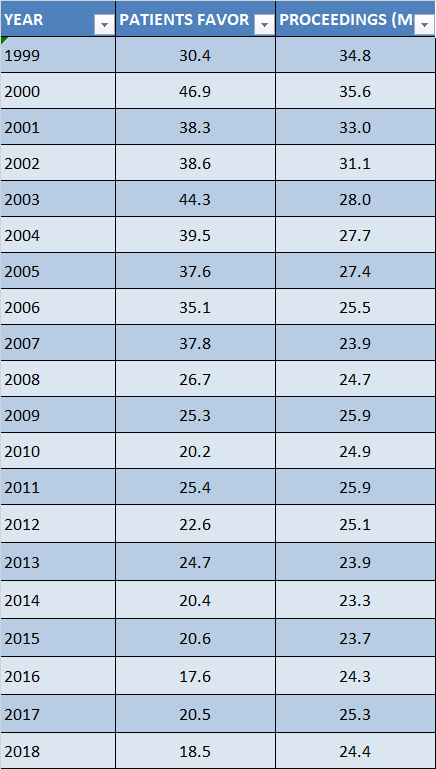
The above data shows the percentage of cases ruled in the plaintiff’s (patient’s) favor and the length of total proceedings before the District Courts on fully litigated medical malpractice cases. As promised by the Supreme Court in 2002, acceleration of civil cases was given a priority, and, as shown above, the average months declined by almost 30 percent from 1999 to 2018.
Interestingly, however, the plaintiff’s win rate declined by 39 percent in the same period. Moreover, during the 19 year interval, these values moved in the same upward or downward direction in 13 years (mostly downward, needless to say), and their correlation is apparent. The question is causation. There may various causes for the phenomenon, improvement of medical care for instance.
But it is a textbook principle that the plaintiff bears the burden of proof, and although the burden of proof is shifted to the defendant in the medical malpractice cases, disparity of information cannot be ignored. One such prime example is the discovery of erroneous DNA analysis in previous criminal cases, which cautions against relying too heavily on presentations of the party who has natural access to a greater amount of information.
この表は地方裁判所の医療関係訴訟(証人調べ事件)で原告(患者側)の勝訴率(一部を含む)と裁判手続の平均月数を示す。もともと民事訴訟の迅速化は2002年の最高裁判所の意見に重視されたポイントの一つであり、1999年から2018年までで、平均月数は30パーセントも低下(短縮)した。
同時に原告の勝訴率もこの期間に39パーセント低下している。しかも、月数と勝訴率は19年間で13年同じ方向に増減(ほとんど減少)しているので相関は明らかだ。問題は因果関係にある。裁判期間にかかわらず、例えば医療の水準が向上したのであれば原告の勝訴率は低下するだろう。しかし立証責任は原告にあるというのが教科書的な原則であり、医療過誤訴訟では病院側に帰責事由のないという証明責任が転換されているとはいえ、情報の偏在を無視してはならない。事実誤ったDNA鑑定による刑事裁判の事例は、情報により広くアクセスできる側のプレゼンテーションに過度に依存する危険を示唆している。